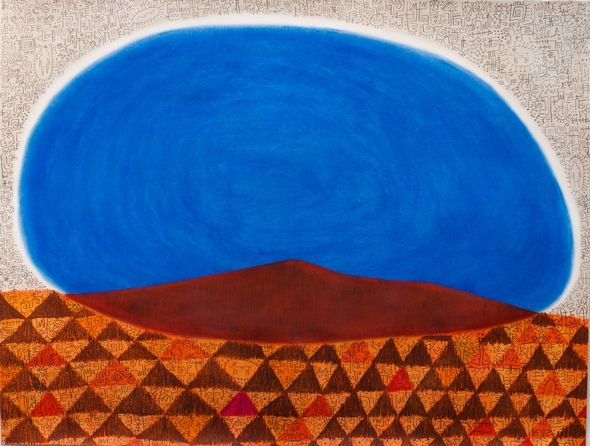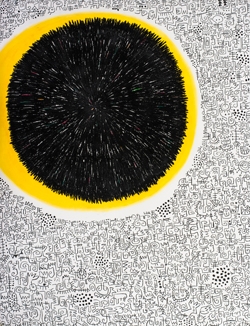The Hood Museum of Art’s new exhibition, “Auto-Graphics,” presents recent work by Nigerian artist Victor Ekpuk. The show is on view from April 18 to Aug. 2.

Victor Ekpuk, “Santa Fe,” 2013, graphite and pastel on paper. (Collection of Fidelity Investments, Albuquerque, New Mexico. © Victor Ekpuk)
The Hood will celebrate the opening of the exhibition, which was curated by Allyson Purpura at the Krannert Art Museum, University of Illinois at Urbana-Champaign, by hosting Ekpuk for a week while he presents a drawing performance, creating a mural directly on the wall of the Hood’s Lathrop Gallery from April 21 through 24.
The week will conclude with a lecture by Ekpuk at 4:30 p.m. on Friday, April 24, followed by a reception and a special tour of the show by Purpura at 11 a.m. on Saturday, April 25. Other programming includes gallery talks and introductory tours of the exhibition.
Hood Curator of African Art Ugochukwu-Smooth C. Nzewi, who arranged for the presentation of the exhibition at the Hood, says, “As a global artist, Ekpuk’s practice is informed by his Nigerian roots and a cosmopolitan consciousness that comes from his numerous international travels to participate in artists’ residency and exhibitions. ‘Auto-Graphics’ presents an important opportunity to introduce the work of a leading contemporary artist to Dartmouth and the Upper Valley, in line with the Hood’s mission to represent the diversity of cultures and artistic practices.”

Victor Ekpuk, “Composition No. 13″ (Sante Fe Suite), 2013, graphic and pastel on paper. (Courtesy of the artist. © Victor Ekpuk)
During his week on campus, Ekpuk will draw a work on the gallery wall—an ample surface on which to explore the infinite potential and ephemeral fate of the hand-drawn line—in what the artist refers to as drawing performance, from April 21 through 24. He invites viewers to follow the rhythms of his drawing and to share in his experience momentarily, without necessarily understanding the marks on the wall. The mural will be erased at the end of the exhibition in a final act, a gesture to life’s ceaseless cycle of birth, death, and renewal.
Ekpuk composes intricate arrangements of script-like forms in a staccato fashion, with symbols ricocheting off each other across carefully amassed picture surfaces. His visual language evolved from the ideographic and gestural nsibidi, the communication system of the Ekpe secret society, a trans-ethnic men’s association active in the southern border regions of Nigeria and Cameroon.
Early in Ekpuk’s career, he was mostly interested in nsibidi as an aesthetic resource, but he has since become adroit at inventing his own scripts of dots, scratches, scrawls, contrived signs, and schematized figures. As Ekpuk has often stated, memory—understood as a stream of consciousness that encapsulates human experiences, lived and imagined, inherited or received, personal and collective—is at the core of his practice. Nsibidi (as well as the artist’s invented signs) represent this idea in his work, inscribed and reiterated on canvas, acid-free paper, board, and, recently, walls.
Born in 1964, Ekpuk trained at Obafemi Awolowo University, Ile-Ife, in southwestern Nigeria, where he was first exposed to the possibilities of drawing. He developed his minimalist approach of reducing form to constituent lines while working as a cartoonist for Daily Times, a leading Nigerian newspaper, in the 1990s. An experimentalist with the gestural qualities and sparse formalism of lines, Ekpuk considers drawing a fundamental aspect of his art practice, which also includes painting, printmaking, collage, sculpture, installation, and public art projects.
The repetition of the artist’s own invented forms juxtaposed with nsibidi signs is characteristic of all 18 works in “Auto-Graphics.” The show includes Ekpuk’s whimsical collages, digital prints, and supersized drawings in which nsibidi emerge as bristling opaque forms that contrast with the more figural works on view.
This exhibition, on view from April 18 to August 2, was organized by Krannert Art Museum, University of Illinois at Urbana-Champaign, and curated by Allyson Purpura. It was partially supported by a grant from the Illinois Arts Council Agency. The exhibition’s presentation at the Hood Museum was generously supported by the Leon C. 1927, Charles L. 1955, and Andrew J. 1984 Greenebaum Fund and the Cissy Patterson Fund.

